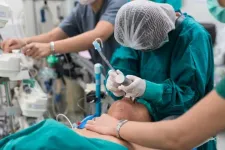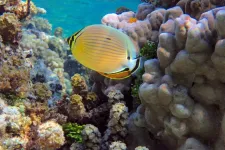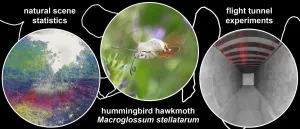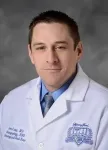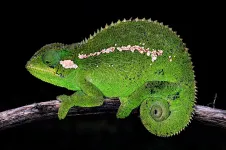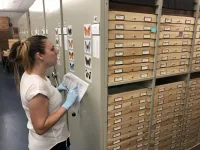Outpatient management following diagnosis of acute pulmonary embolism
2021-03-23
(Press-News.org) Despite guidelines promoting outpatient management of patients with low-risk pulmonary embolism (PE), few patients are currently discharged home from hospital emergency departments in the United States. That is the conclusion of a study titled Outpatient Management of Patients Following Diagnosis of Acute Pulmonary Embolism, published in the March 2021 issue of Academic Emergency Medicine (AEM), a journal of the Society for Academic Emergency Medicine (SAEM).
The retrospective cohort study of more than 61,000 patients treated at 740 acute care United States emergency departments during a two-year period sought to determine disposition practices and subsequent health care utilization in patients with acute PE. According to the findings, disposition practice varies widely across hospitals and return emergency department visit rates were high, but most did not result in hospitalization.
The lead author of the study is Lauren M. Westafer, DO, MPH, MS, of the Institute for Healthcare Delivery and Population Science at the University of Massachusetts Medical School and the Department of Emergency Medicine, University of Massachusetts Medical School-Baystate, both in Springfield, Massachusetts.
The findings of the study are discussed with the author in a recent AEM podcast titled Momma I'm Comin Home - for Outpatient Treatment of a Pulmonary Embolism.
INFORMATION:
ABOUT ACADEMIC EMERGENCY MEDICINE
Academic Emergency Medicine, the monthly journal of Society for Academic Emergency Medicine, features the best in peer-reviewed, cutting-edge original research relevant to the practice and investigation of emergency care. The above study is published open access and can be downloaded by following the DOI link: 10.1111/acem.14181. Journalists wishing to interview the authors may contact Tami Craig at tcraig@saem.org.
ABOUT THE SOCIETY FOR ACADEMIC EMERGENCY MEDICINE
SAEM is a 501(c)(3) not-for-profit organization dedicated to the improvement of care of the acutely ill and injured patient by leading the advancement of academic emergency medicine through education and research, advocacy and professional development. To lean more, visit saem.org.
ELSE PRESS RELEASES FROM THIS DATE:
2021-03-23
A study co-authored by researchers at the Johns Hopkins Bloomberg School of Public Health found that telehealth consults among privately insured working-age patients accounted for almost 24 percent of outpatient consults with health care providers during the early phase of the pandemic, March to June 2020, up from less than 0.3 percent during the same period in 2019.
The dramatic shift occurred as many medical practices halted or curtailed in-person office hours and patients stayed away from doctor's offices out of fear of transmission during the early months of the pandemic. At the same time, insurance companies and the federal government relaxed policies around telehealth to meet demand for remote medical consults ...
2021-03-23
Most people relate cholesterol to heart health, but it is also a critical component in the growth and spread of brain cancer. VCU Massey Cancer Center researcher Suyun Huang, Ph.D., recently discovered how cholesterol becomes dysregulated in brain cancer cells and showed that the gene responsible for it could be a target for future drugs.
The mean survival of patients with the most common and aggressive type of brain cancer, glioblastoma multiforme (GBM), is 14 months. The need to find new, effective treatments is urgent and has driven Huang, a member of the Cancer Biology research program at Massey, to detail ...
2021-03-23
Some 40% of critically ill patients who undergo tracheal intubation to support their breathing suffer a life-threatening complication, research from National University of Ireland Galway has revealed.
The study, published today in JAMA: The Journal of the American Medical Association, involved 2,964 critically ill men and women. It was carried out across 29 countries from 1 October 2018 to 31 July 2019 to determine the risk of adverse events arising from the invasive procedure.
John Laffey, Professor of Intensive Care Medicine at NUI Galway and Consultant in ...
2021-03-23
HOUSTON - (March 23, 2021) - Fish that dine on corals may pay it forward with poop.
It's an unexpected twist on coral reef symbiosis, said Rice University marine biologist Adrienne Correa, whose lab discovered coral predator feces are jam-packed with living symbiotic algae that corals depend on for survival. The discovery confirms that poop from coral-eating fish is an important environmental source of symbiotic dinoflagellate algae on coral reefs.
Correa said coral-eating predators are typically thought of as biting and weakening reef structures, thereby generating hiding spaces for other organisms and, ultimately, beach sand. In contrast, grazing fish that crop down bushy algae get the limelight for helping reefs maintain healthy coral ...
2021-03-23
Hummingbird hawkmoths are small insects that hover in the air like hummingbirds when drinking nectar from flowers. Dr. Anna Stöckl from the Biocentre of the Julius-Maximilians-Universität (JMU) Würzburg in Bavaria, Germany, is studying the visual performance of these insects. Dr. Stöckl and her doctoral student Ronja Bigge now present their latest findings in the journal Current Biology.
"To control their flight, hummingbird hawkmoths rely on optic flow in the lower half of their visual field," Ronja Bigge explains. Optic flow is the relative motion that the surrounding image casts on the animals' retinas when they fly. We experience this phenomenon ourselves when travelling by train ...
2021-03-23
DETROIT (March, 23, 2021) - Henry Ford physician, John Craig, M.D., is leading an international research effort to improve the multidisciplinary collaboration between otolaryngologists and dental providers around the globe when it comes to diagnosing odontogenic sinusitis (ODS).
ODS is an infectious condition of the paranasal sinuses that can occur from either dental infection or dental procedures involving the upper jaw. There are multiple ways that infection can spread from the teeth to sinuses, and in more severe scenarios, to the eye, brain, or rest of the body. It has been shown that the various clinicians ...
2021-03-23
Rural America is running short on physicians. This worries health experts who have linked limited access to primary care providers to major gaps in health outcomes for rural communities.
Addressing this issue is complicated, but new research from the University of Georgia suggests that understanding geographic trends in medical school applicants could help project where the future physician workforce is likely to practice.
Knowing a medical student's hometown is an important piece of the puzzle, said study author Donglan "Stacy" Zhang, because geography is known to predict where many new doctors choose to practice.
"More than 60% of doctors choose their practice location in ...
2021-03-23
The Bale Mountains in south-central Ethiopia are considered to be one of the most unique centers of endemism, with an extraordinary number of plants and animals that can only be found there. Numerous species are already known from this Afromontane high-elevation plateau, making it a biodiversity hotspot, but ongoing research continues to reveal the presence of so far unknown and undescribed organisms.
Zoologists END ...
2021-03-23
WASHINGTON--Exposure in the womb to a drug used to prevent miscarriage appears to raise the offspring's cancer risk decades later, especially for colorectal and prostate cancers, researchers have found. They will present the results of their new study Tuesday at ENDO 2021, the Endocrine Society's annual meeting.
Some adult children of women who received the drug, hydroxyprogesterone caproate (OHPC or 17-OHPC), during pregnancy in the 1950s and 1960s are now experiencing more than twice the odds of cancer, said the study's lead researcher, Caitlin Murphy, Ph.D., M.P.H., an assistant professor at the University of Texas Southwestern Medical Center in Dallas, Texas.
OHPC is a synthetic progestogen hormone that was ...
2021-03-23
By comparing the genetic diversity of butterflies in North America, researchers reporting in the journal iScience on March 23 found that the array of different evolutionary distinct groups of butterflies is particularly high in the deserts of Mexico and the southwestern United States. This may be an outcome of actively changing conditions in the Desert Southwest and more generally in the western portion of the continent.
"When you think of desert, you don't automatically jump to butterflies, but our results showed that this area is actually a really important hotspot for butterflies, even if it isn't for plants," says co-first author Chandra Earl, who recently received her PhD from the University of Florida. "Just because butterflies are closely tied to their host plants doesn't ...
LAST 30 PRESS RELEASES:
[Press-News.org] Outpatient management following diagnosis of acute pulmonary embolism
